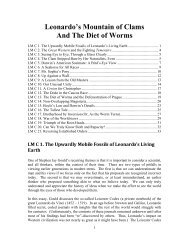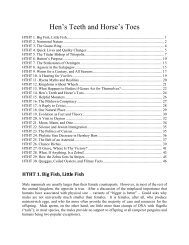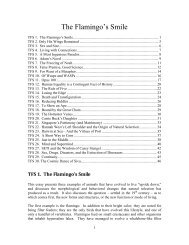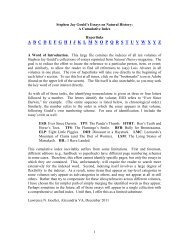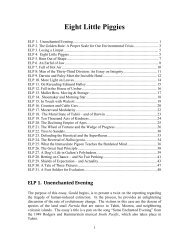Case Four, in Gould’s words, is “the smoking gun.” The January 14, 1994 issue of thejournal Science contained a description of a very well preserved fossil of a new genus,which the authors named Ambulocetus, and would have weighed about 600 pounds inlife. It was found in the same Pakistani sediments as Pakicetus, but about 120 metershigher, and therefore slightly younger. Its rear feet were, in the words of the authors,“enormous,” and each toe terminates in a small hoof. It did not have a tail fluke, butrather a terrestrial mammal’s long, thin tail. The rear vertebrae show that it propelleditself through the water with powerful up-and-down strokes of the rear portion of itsspine, much like a tiger running (rear legs together). This is consistent with the animal’sorigins as a terrestrial predator, and offers insight into why whales today undulate theirspine up and down for propulsion, rather than the side-to-side technique employed byfish. The authors recognize that the up-down swimming motion of cetaceans thusdeveloped before the tail fluke, and apparently employed the animals legs (in somefashion) for propulsion instead. Ambulocetus could also clearly move on land, althoughits front legs were shorter than its rear. It is the very creature, Gould states, thatcreationists argued could not exist.Gould wrote this essay shortly after the Science article on Ambulocetus appeared. Threemonths later, too late for the essay, another discovery was reported; Gould includes adiscussion of it as an epilogue. Case Five, in this convention, is a smaller, 10-foot whalecalled Rodhocetus. It lived about 46.5 million years ago, and is about 3 million yearsyounger than Ambulocetus (Case Four, the smoking gun), and about the same age as<strong>In</strong>docetus (Case Three). Although the tail is not preserved, the spinal column betweenthe head and pelvis is complete, along with the pelvis itself and a few leg bones. Severalfeatures identify Rodhocetus as another beautifully intermediate creature. The vertebralspines near the neck are long, as is the case with terrestrial animals where strong musclesare required to hold up the head. However, the neck vertebrae themselves are shortened,a feature which limits head turning but supports more efficient motion through the water.The lumbar vertebrae are still directly connected to the hipbones, which is required forsupporting its weight on land. However, these vertebrae are fused (for strength) interrestrial animals, but unfused in Rodhocetus, as in modern cetaceans. This allows for amuch smoother and more powerful stroke when swimming. The rear leg itself is muchlarger than Basilosaurus, but considerably smaller than Ambulocetus. Thus, it is possiblethat Rodhocetus spent some time on land, but it is by no means certain. Finally, it wasfound in deep-water ocean sediments, indicating that it could dive more deeply than olderproto-whales.DIH 29. A Special Fondness for BeetlesNatural theology [ELP 9] was a mainstream form of creationism that began in the era ofRobert Boyle [LMC 15], a 17 th -century colleague of Newton, and formalized by WilliamPaley in 1802. Its two tenants are that the existence of God can be inferred from HisCreation, which shows intelligent design (and continues to exist in certain pseudointellectualcircles), and that His goodness can be inferred from it as well [HTHT 2discusses the drawbacks of this second premise]. <strong>In</strong> the 20 th century, well after thescientific community had abandoned natural theology, a story has it that one or more38
theologians asked the great biologist J. B. S. Haldane (1892 – 1964) a question thatpresumed this view. What, the question went, can we conclude as to the nature of theCreator from a study of His creation? The answer Haldane gave, which Gould tells us isthe single most famous one-liner in evolutionary biology, is: “An inordinate fondness forbeetles.” With his fascination of human story telling and modes of processinginformation, Gould spends the first part of this essay discussing his efforts to track downthe actual quote and its true context.He tells us that he has been keeping a file on this quote for ten years, but it was a heatedexchange of letters to the editor in a British journals Nature and The Linnean thatprompted this essay. It began with an article that, in passing, referenced the questioningtheologian as being the famous scholar, Benjamin Jowett; this is unlikely, as he died theyear after Haldane was born. <strong>In</strong> the firestorm that followed, several pieces of informationwere elicited from people who knew Haldane. It turns out that he used the phrase oftenin speeches and lectures, but never identified the theologian (perhaps there was none).Haldane himself did not write the quote down. One on-the-record response from theexchange of letters states that he did, in fact, say “an inordinate fondness for beetles.”The one contemporary mention of the quote actually has him saying that the Creator, ifhe exists, must have “a special preference for beetles” – not quite the same. A thirdreference, also from the letter, adds that Haldane sometimes said “a special preference forstars and beetles.” Gould draws the essay’s title as a compromise between these last twoversions. His reason for going on about this topic is that it illustrates three common waysin which humans change stories to embellish them. The first refers to who actually saidit; often such a quote may be attributed to someone more important or famous. (Thisquote has been attributed to Thomas Huxley on occasion.) Haldane himself was famousenough to not require this, but it may explain the use of Benjamin Jowett as his foil inone version. The second is, what were the circumstances? The story always works bestif it was an impromptu response to a hostile remark. Finally, what were the exact words?Often the actual response is not witty enough to satisfy the story, and must beembellished. Such is human nature, not only in the area of fiction but also in what issupposed to be history.The essay then changes direction, turning to discuss the question of how much fondnessthe Creator – literally or metaphorically – really does have for beetles. One survey of thedata at the time found that 1.82 million species of animals and plants (but not fungi orunicellular organisms) had been named and described in the literature. Of this total,about a quarter are, in fact beetles, while well over half are insects of one form oranother; this would seem to make the point. However, Gould continues that these figuresmay only the tip of the iceberg. While the discovery of a new vertebrate is a rare event,this is not the case with arthropods. What, then, is the actual number of species of beetleon earth? The estimates vary widely, but a common estimate is 30 million species. Thisparticular estimate is based on a combination of assumptions and fieldwork performed byTerry Erwin, an American entomologist. <strong>In</strong> the early 1980’s, he took examples of 19different species of rain-forest tree, fogged them with insecticide, and collectedeverything that fell out in fine nets. He then made a series of assumptions, such as howmany beetles were unique to that one species of tree. He established his estimate by39
- Page 4 and 5: cloud (“nebula”) of gas and dus
- Page 6 and 7: goodness, and is both intelligent a
- Page 9: The second news story involves the
- Page 12 and 13: key ways. Prior to 1994, no fossil
- Page 14: DIH 11. Lucy on the Earth in Stasis
- Page 17: directly resulted in a mass extinct
- Page 20 and 21: Edgar Allan Poe, it turns out, wrot
- Page 22 and 23: things male, while the beautiful is
- Page 24 and 25: interest, until the entrepreneur of
- Page 26 and 27: essay is that scientists, for all t
- Page 28 and 29: DIH 23. The Smoking Gun of Eugenics
- Page 30 and 31: half-Jewish meant Jewish, while qua
- Page 32 and 33: Darwin’s theory, like Adam Smith
- Page 34 and 35: What might a better definition of t
- Page 36 and 37: type of soil, amount of rain, and s
- Page 40 and 41: multiplying his findings by the num
- Page 42 and 43: other departments, something that r
- Page 44 and 45: Linnaeus, Gould states, did not sim
- Page 46: greatly prefers these metaphors, on




